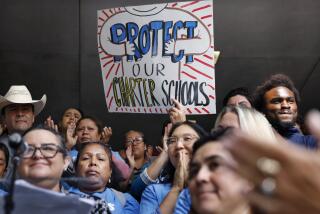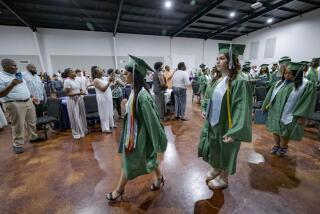L.A. Unified, 7 others get waivers from No Child Left Behind

L.A. Unified and seven other California school districts on Tuesday won relief from some strict and costly provisions of federal education law.
They are the first school systems in the country to receive, on their own, a waiver from the No Child Left Behind law. Previously, federal officials had only granted exceptions to states, when they met conditions for applying. California had sought a waiver and was turned down; the eight districts formed a group to seek relief on their own.
Besides Los Angeles, the school districts are Long Beach, Santa Ana, Fresno, Oakland, Sacramento, San Francisco and Sanger.
One key condition is that the school districts must evaluate teachers based on student academic growth, which typically means standardized test scores.
U.S. Secretary of Education Arne Duncan, who announced the waiver in a telephone call with reporters, preferred to focus on other elements of the plan, notably that more students will be included in measuring the success of a school.
For example, under current state rules, the performance of black students, as a group, only is considered if there are more than 100 African American students at a school. (That number is 50 for small schools.) So those black students could be doing poorly and it wouldn’t matter in terms of a school’s rating. Now, the performance of these students will count if there are as few as 20 in a school.
This new rule also will apply to Latinos, low-income students, those learning English and disabled students. In all, the performance of 150,000 students in these groups will count for the first time.
The eight districts enroll a total of more than one million students.
Duncan said this change means that the progress of such students will no longer be “invisible.”
In addition, to determine how well schools are doing, other such factors as graduation rates and student and parent surveys would be incorporated.
The No Child Left Behind law, enacted under former President George W. Bush, was intended as an accountability system that would lead to nearly all students being “proficient” in English and math by 2014. It forced states to pay more attention to student achievement, especially as measured by standardized tests. But critics say it also has resulted in nearly all schools being judged as “failing” for not meeting nearly impossible improvement targets.
Teacher unions in these districts opposed the waiver process, in large measure over concerns about the use of student test scores in teacher evaluations.
“This top-down move that excluded teacher input is absurd, counterproductive and divisive,” said Dean E. Vogel, president of the California Teachers Assn.
Some state officials, including state Supt. of Public Instruction Tom Torlakson, have expressed concern about some school districts falling under different rules than others.
“All California schools deserve relief from the unworkable mandates of No Child Left Behind, so it’s noteworthy that a few districts have — temporarily at least — managed to navigate the complex waiver requirements imposed by the [Obama] Administration,” Torlakson said in a statement.
ALSO:
Hot on the trail of a kidnapped iPhone
L.A. City Council backs new boardwalk barriers
Falls fire near Lake Elsinore 20% contained, officials say
Twitter: @howardblume
More to Read
Start your day right
Sign up for Essential California for news, features and recommendations from the L.A. Times and beyond in your inbox six days a week.
You may occasionally receive promotional content from the Los Angeles Times.







